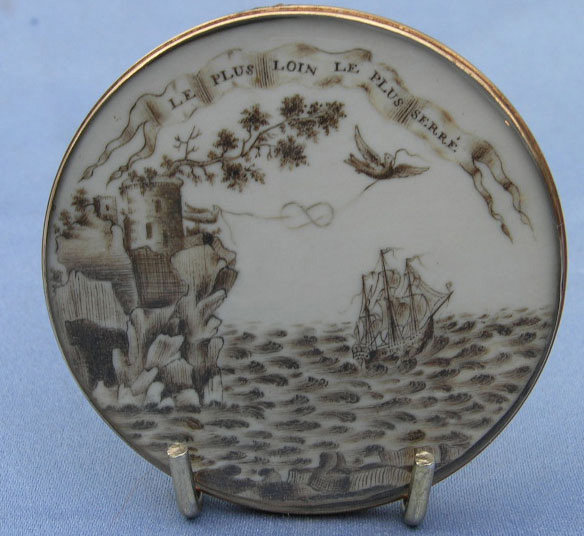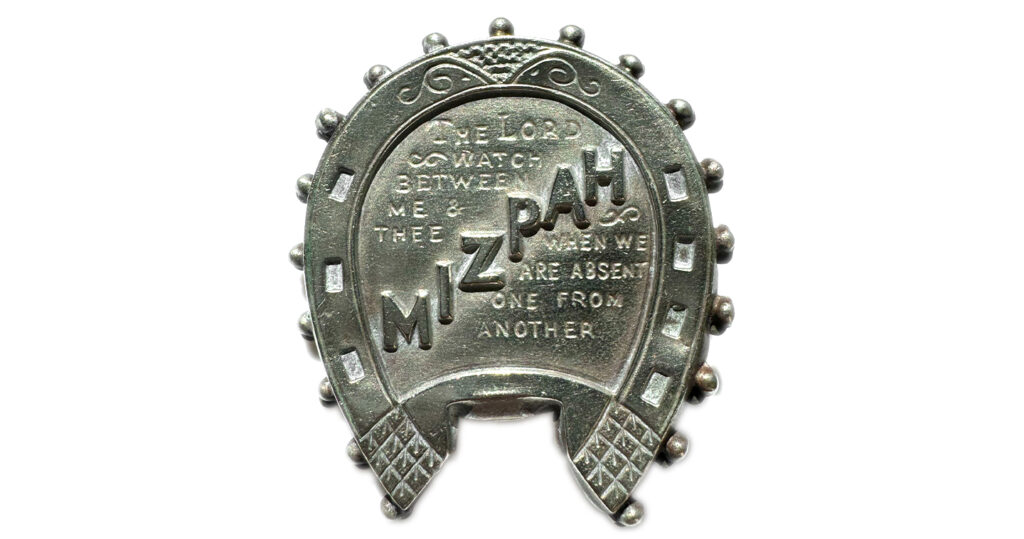Castles, Rivers, Boats and Classical Discovery in Jewellery
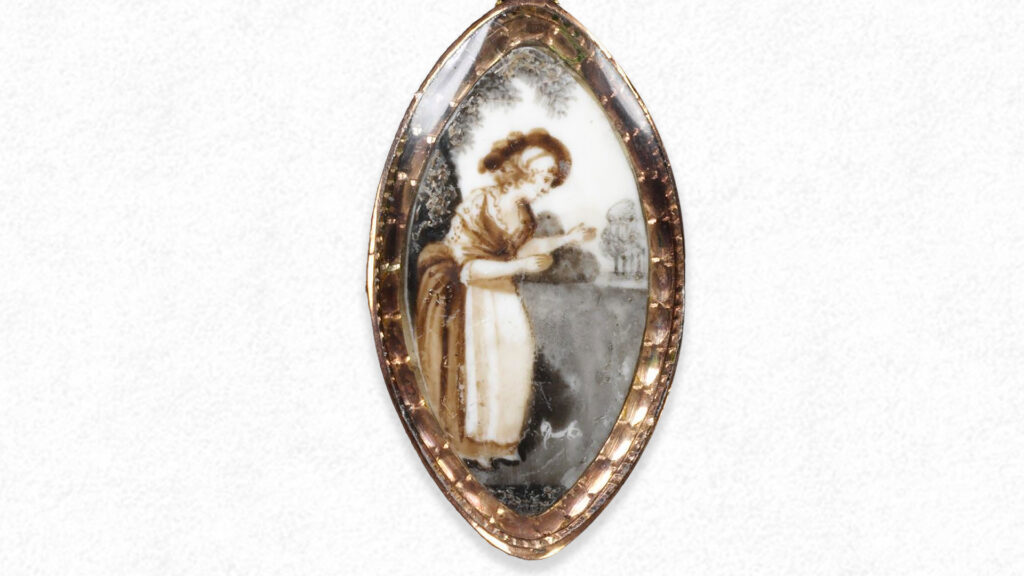
Identity is connected to history. Through the values, art and concepts of previous cultures, our identity is legitimised when we can connect our heritage to those establishers of culture and civilisation. Connecting modern cultures to classical ones have been important for emperors and kings in order to promote their rule and stabilise their cultures, but how could this be introduced?
Creating jewels like the ones that are the nature of this article aren’t just happenstance. There are many factors that led to the idyllic depiction of a boat crossing a river with a classical structure in the background, flanked by trees and castles. Such rich symbolism is the culmination of human experience and understanding, otherwise the tale that the jewels tell is meaningless. Cultures faced high mobility in the 18th century (the first ring from this article is from 1768), and jewels could be worn from one culture to the next, passing on their message of love or grief. What these jewels represent is the start contrast that had turned the memento mori jewellery of skulls, crossbones and the literal desecration of the body, into a seemingly serene and beautiful landscape. How could societies adapt so rapidly towards this through Europe?
Once again, identity is the main issue. Destabilisation of governments, the questioning of the monarchy, science and religion all led to what presented these jewels within society. The Age of Enlightenment paved the way for the Neoclassical period (c.1760) to interpret human emotion through classical concepts. The Enlightenment was spurred on through debate and discovery throughout various disciplines by thinkers such as Rousseau, Diderot, Voltaire, Locke, Bacon and Newton. Such thinkers challenged the very nature of engrained and understood concepts of the world. These concepts had been destabilised since Martin Luther wrote the Ninety-Five Theses in 1517. The challenge to ecclesiastical thinking and its establishment of the Protestant Reformation had effectively enhanced the artistic value of English jewels through the Huguenot emigration and the goldsmith knowledge that they bought with them. This was 1686, from the revocation of the Edict of the Nantes and over a century since England had split from the Catholic church (1529-1537).
The impact that the Reformation made across Europe caused an even greater schism in how jewels of love and grief were depicted. On one side, the nature of the soul being judged by the Holy Trinity and finding solace within the company of Jesus was still the mainstream thought. This required no questioning of where the soul would go, as long as the individual lived a life of piety, and the use of the crucified Christ, saint or angel was enough to comfort the loved one and identify mourning, along with black costume. With the Reformation challenging the concept of religion, symbols of death became more complicated and more literal. Intellectualism had appropriated the memento mori style and presented it in a way which would denote the wearer to be understanding of their mortality and living life to its fullest. Until the Huguenot integration within England and the relative stabilisation that the Restoration of the crown under Charles II had bought, the symbols of memento mori became the symbols of death. Being judged by a higher power was never in question, but what was identified as death was the individual. The body and its return to the earth made death literal in jewels; those who wore them were aware of their fate and those that saw them identified that within the culture. Now it was more important to make the most of time, as it was fleeting. Hence, the thinkers which made the Enlightenment possible utilised this thinking and approached the nature of life and the universe with science, logic and fact.
What better way to identify challenge than through antiquity? Appropriating the symbols of the classical Greek and Roman eras to question what had come in between. These monuments of antiquity did not disappear in the post-Roman world; they were not as accessible as before. With such strong values in religion and the monarchy that had effectively protected and developed Europe from invasion or destabilisation, the time was right to introduce those classical elements into contemporary culture, identify with them and use them for symbolism.
Archaeological excavation was also another important element to the growth of classical culture in the 18th century. Pompeii and Herculaneum had discoveries in 1711, but resumed with major excavations in 1738, igniting the passion and interest in artists, thinkers and antiquarians. The ‘Grand Tour’, a social institution since c.1660, was an upper-class, male rite of passage which the tourist would be taken by a tutor, servant and a coach, through the Alps, Seine to Paris or Rhine to Basel. Switzerland would be next, with a trip through to northern Italy and down to Naples, then through to Germany and back across to England. Each of these places was held in educational regard. Elements from history or cultural education (fencing, mountaineering, history, riding) were all absorbed from the relevant societies. Tokens from the Grand Tour were common to return to England with, such as the pendant below, which shows the elements of mortality:
With the archaeological excavations, one can imagine the surprise and delight of discovering the classical heritage which could be taken back to their homelands and recreated for modernity. Herculaneum was described by Sir Horace Walpole as ‘a whole Roman town, with all its edifices, remaining under ground’, meaning that a pristine site of research was offered to modern craftspeople to replicate or be inspired by. Architecture is one of the most persuasive and organic styles of design that permeates culture. Architecture is grand and dominating, not allowing anyone to pass by it without noting its style. When architects such as Robert Adam used the past for aesthetic taste, classical influence in Scotland and England could not be stopped. In 1748, Giovanni Battista Piranesi began etching classical structures and in 1755, Adam on his Grand Tour met Piranesi met, allowing Adam to return with further inspiration in classical style.
Of Castles and Monuments
What is most overt about these jewels that are the subject of this article is the use of architecture. Both jewels have commons themes; on the left of the river there is a classical, modern structure, and to the right are the crumbling castle battlements. Overgrown and hollow, these battlements are deteriorating, yet the ‘modern’ building on the left is pristine and new. What is remarkable from a contemporary perspective is how these ‘modern’ buildings were designed. There’s a high level of the romantic about them, but both share the introduction of classical style in their makeup, but are still showing signs of earlier castle keep and roof design. The brooch, in particular, has a simpler design to the building, while the ring has more classical elements in the greater influence of it being a temple. Further to this, the roof is adorned with the cross, signifying a church.
Both of their allegories are the same, with the soul departing life into death. Life, being the lit structure to the left and death being the place of decay and emptiness. It is also a meaning for the life itself, as the soul has left the body and the body returns to the earth. A wonderfully memento mori concept that is interpreted through allegory.
Another reason for the castle is that it is safe and steadfast. The castle, or monument, is not just a place of worship, it is a genuine haven of strength that will not break. When considering this and the wearer representing the keeper of the love for another, the monument represents that the love held will not waver or fall, but remain for the loved one. In the example above, the token is for the sentiment of distance only creating a stronger tie between two people, regardless if that is death or physical proximity. Love, kept safe forever, suffers the hardships of time, weather and the elements, but it will always remain a constant between the two people.
Through both of the pieces that are primary to this article, classicism has already created a canvas for which grieving people can identify through allegory. It not for the thinkers that had progressed cultural identity, symbolic identity could not change. Now, a jewel which has several elements that need to be interpreted in order to be understood could be worn at the neck, wrist or hand with enough identity to become a jewel of death. Architecture is highly influential in the permeation of the Neoclassical concept. As previously stated, temples, monuments, buildings and houses are contemporary identity. With a culture that was facing rapid increases in technology for higher and cheaper production, things as simple as the humble brick could be produced in high enough quantity to build structures of identity. The Industrial Revolution post c.1760 was integral to the growth of Neoclassical style and a catalyst for jewels such as these.
Trees
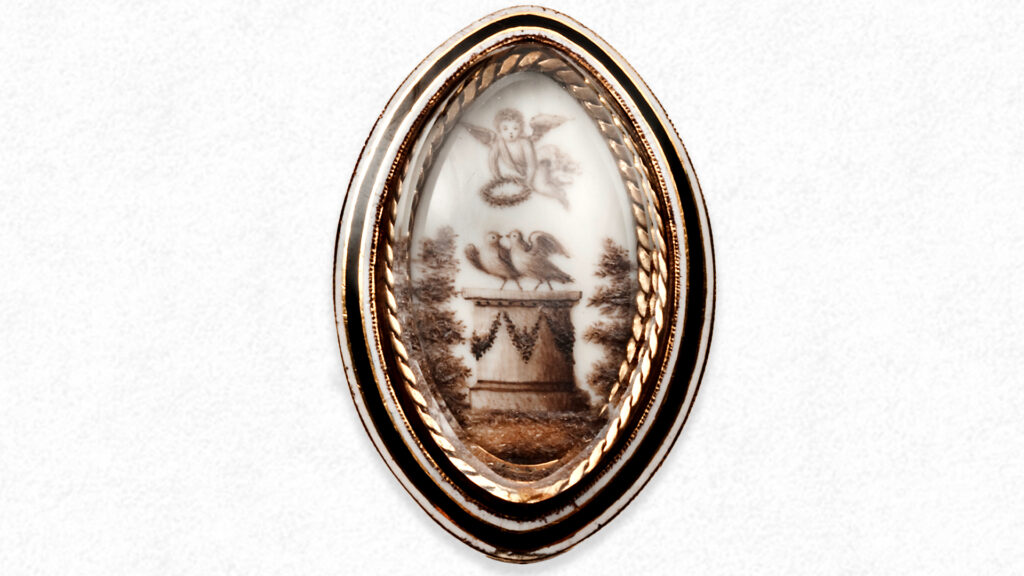
Trees are stronger, taller and older than us all, monuments within their own right. In the brooch and ring, we see two variations of the tree and multiple meanings simply based upon their species. The most overt are the oak trees, which are the symbols of hospitality, stability, strength, honour, eternity, endurance and liberty. Essentially, the oak represents life in its strongest form, being much larger than human scale and the emblem of strength. Yet, note the ring. In the ring, we can see that there are two next to each other at the shore, with one broken. The two people personified in timeless love, yet one life cut short.
As with the monument, the life is still on the left and the death is on the right. The brooch has a much crisper and idyllic depiction, which works in the favour of the ring, as there was quite a lot of predesigning jewels with symbolism and tailoring them to the wearer (in the inscription or dedication). One can often tell through the use of different coloured paints to approximate the style, or through the awkward lettering which may cause words to be truncated across a Neoclassical jewel.
In the ring, the second most popular tree used in mourning can be seen. Cupressus sempervirens, or the ‘Graveyard Cypress’ is one of the oldest classical mourning symbols used in Western and Eastern societies and its importance and longevity are are just as timeless as the tree itself.
Known as the ‘mournful tree’ by the Greeks and the Romans, the tree was sacred to the Fates and Furies as well as the rulers of the underworld. The tree would be planted by a grave, in front of the house or vestibule as a warning against outsiders entering a place corrupted by a dead body. Romans would carry branches of cypress as a sign of respect and bodies of the respected were placed upon cypress branches previous to interment. It is such for reasons as this that the tree still survives in the Muslim world and in Western culture, the cypress designates hope, as the tree points to the heavens. Here, there is a great continuity of usage for the tree, as despite its cultural interchange, it still remains understood for the same purposes in death.
It is the usage for its heavenly motif that we focus on for jewellery in the Neoclassical era, as the period of around 1760 is when the symbol came into regular mourning depictions, painted on ivory or vellum. The cypress is mostly shown in the background to the willow in the foreground of a mourning depiction, as the mourning woman would often interact with an urn, tomb or willow, but rarely with the cypress itself. Due to is constant usage in cemeteries and reflecting the classical usage of planting a cypress upon death, the cypress is still most commonly seen at the graveyard and the mourning depictions of the tomb or urn on plinth are reflective of that. The cypress’ seen flank the cemetery as they would in reality. Other depictions of the cypress may be the lonely cypress on a rocky outcrop or a singular cypress surrounded by other mourning symbols.
By the 19th century, the cypress was depicted in leaves and branches on jewellery, rather than the full sized depiction. In this way, it could be utilised with other symbols as the Neoclassical concept of depicting full mourning scenes had given way to more specialised and smaller depictions of individual symbols to convey a meaning.
Togetherness
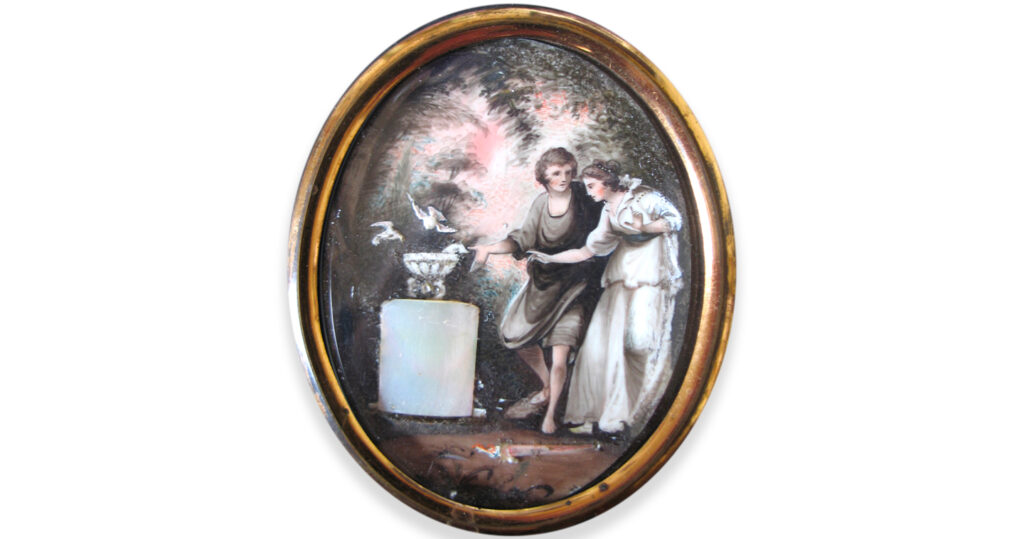
Piety is important and the most fundamental factor in mourning jewels. Particularly in the late 18th century, piety and fidelity were elements which weren’t hidden away from the wearer, such as in posie rings, where the sentiment for the lover was inscribed inside the band, but overtly stated on the front of the jewel. In the brooch, this is seen twice, with the master and the dog walking across the bridge and the two people rowing the boat across the river. Both of these signs show how the proximity between people is being amplified, with no one making the voyage alone. There is inherent piety in the use of the dog, which is seen as the symbol of fidelity and trust to the master. What is most interesting is that the dog’s tail being reversed away from the master shows the dog moving away into death upon the right, with the castle and the broken battlements. The two lovers are separating, with one moving back to life and the other to death
Within the river, the allegory for the River Styx brings the pieces back to their classical elements. In Greek mythology, the Styx was the boundary between the Underworld/Hades and Earth. The other five rivers that separate Hades (hate) from the living world are the Acheron (woe), Cocytus (lamentation), Phlegethon (fire) and Lethe (forgetfulness). In mythology, Charon is the ferryman crosses the Acheron takes the dead to the underworld, where Cerberus guards. A coin (obol) was placed in the mouths during burial to pay the ferryman safe passage.
What the brooch and the ring lack are torment. There’s nothing in them to suggest that the rivers were of torment, but of serenity. The allegory carries forward, however, with the ring carrying a passenger, but the brooch has both people rowing the boat. There’s no separation or dominance suggested in the depiction of the characters; they’re both equal and acknowledging each other. The water itself is enough to denote crossing, distance and separation. Two souls on either side of the shore cannot be joined without a crossing, and these pieces, one also with a bridge, shows a passage from life into death.
Souvenir
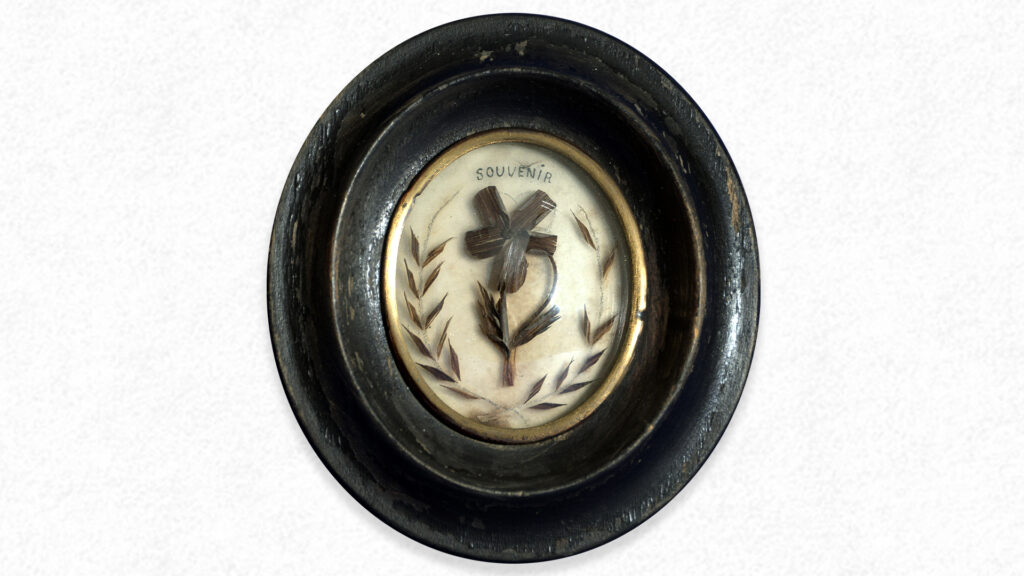
Mourning bequeathments had been in popular thought since the late 16th century, but became indoctrinated through the 17th century. Most famously, William Shakespeare in 1616 declared that in his will that his daughter and wife should have rings stating “Love My Memory”. He also details a donation of rings to three (such as Burbage) of his acting colleagues.
Samuel Pepys bequeathed 123 rings upon his death in 1703. These rings were graded into three classes and given out according to proximity of friendship and social status. So typical as a token of giving at a funeral, Pepys wrote in his diary:
“This day my Lady Batten and my wife were at the burial of a daughter of Sir John Cawson’s and had rings for themselves and their husbands.”
The period of the second half of the 17th century was the time of the Restoration of the British Crown and a time when industries were growing to accommodate a growing middle class through technological advancements. Through this, the custom of highly produced rings led to cheaper cost. Robert Walpole, Earl of Oxford, died in 1700 and bequeathed 72 rings at £1 each to friends and family, based on the same principles as Pepys.
The token of a mourning jewel as a device of remembrance becomes ingrained within a realm of society that had not needed a standardisation of a token of remembrance (as defined by court), but the thought had seeded its way into society.
This custom, though used, was not as popular as the latter half of the 17th Century would prove, though is provides a good basis for what was to come. Posy rings, typically bands with inscriptions, were popular for sentimental purposes during the 17th Century.
As the Neoclassical period developed, the use of ‘souvenir’ in jewels was related to the multiple bequeathments that could be produced upon death and the allocation in the will for jewellery production. Souvenir jewels could also be produced for sentimental and memorial purposes (jewels created for travel or the death/impact of a famous person or moment). It was about increased production and the ability to afford items that would have been only relegated to the aristocracy previously.
With the rise of the Industrial Revolution, increased manufacture of textiles, steam power and iron making led to the need for a society that could sell these products, creating work for peddlers in towns with growing populations, creating points of sale to growing societies which had previously been smaller and more insular. With heavy investment in inventions from the early 18th century, the growth of mechanised production was rapid. Inventions, such as the John Kay’s flying shuttle (patented in 1733) doubled the output of a weaver, were financed and patented to protect their intellectual property, creating extremely high return on investment for entrepreneurs, such as Richard Arkwright and developing industrial towns, the likes of which had not been seen in modern society. Indeed, Arkwright had amassed £500,000 by his death in 1792. Considering that a very fine silk dress in the early 18th century costed £10 to £60, this amassed wealth is incredible.
Neoclassicism had become the reaction of culture towards the dominant styles of Baroque and Rocco in art and architecture through England and France, which was mainly a reaction of religious questioning. The Baroque style was dominant in its grandeur; enforcing the rule of God upon a society who could not achieve the wealth to acquire such opulent architecture that would be found in a Church or aristocratic setting, hence the presence of God within art was a constant reminder of mortality. The Age of Enlightenment allowed for liberalism in thought and the right of the individual. John Locke and Thomas Hobbs were greatly influential in 17th century English progressive thought, whose resonance would be felt throughout the 18th century. In jewellery, the Neoclassical period led to the change from the actual depiction of mortality through the Memento Mori style (skulls, skeletons, scythes, tempus fugit) were replaced with allegorical depictions from classical art. The weeping female figure next to a tomb or plinth, dressed in classical costume were more typical to find by the 1790s, when the English Enlightenment had reached its height.
What this shows is the swing against the traditional domination of a singular religious thought, to the more literal appreciation of interpersonal relationships. For rings such as this one, it is a shift towards uniformity across cultures that would previously have been separated cultures. Combined with the growing levels of wealth through industry over aristocratic birth and there is the need for a new interpretation of mourning in a single culture.
The French adoption of mourning and sentimental symbolism differed from the necessity of the British. While Court mandates enforced multiple levels of society to enter mourning stages and present the family within a mourning paradigm, the French specifically targeted the art and culture of mourning in a more focused manner from the late 18th to late 19th century, often stemming from form following fashion. As mourning styles and materials became popular (such as hairwork), it was more entitled to enter French style. Much of this is due to religion, approach to culture and how it was mandated throughout the country. The 1789 Declaration of the Rights of Man and of the Citizen offered a freedom of religion, hence no control through Roman Catholicism, or in the case of the United Kingdom, the Church of England with the monarch as its Supreme Governor. This gives greater interpretation of mourning symbolism that can relate more specifically to the wearer and not be dominated by a preordained set of values.
The 18th century welcomed in greater convention for mourning fashion and began to see the rise of the mourning industry. This became so much so that mourning dress was becoming desirable and the difference between mourning and non mourning dress was narrowing. Much of the fashion in this century was dictated by the fabric rather than the cut, and the silk industries in France and England held major influence on mourning wear because of this. It was Ordre Chronologique des Deuils de la Cour, (1765) where details of Court mourning in France were published, giving precise tailoring instructions. From their first days in mourning, men were permitted to appear in Court, unless it was after the death of a parent from whom they had received inheritance.
Widows had to wait one year and six weeks, with the first six months in black wool. Lord Chamberlain and Earl Marshall both ordered shorter periods of mourning in France and England respectively. By the 1880s in Britain, twelve weeks of mourning were ordered by the death of a king or queen, six weeks after the death of a son or daughter of the sovereign, three weeks for the monarch’s brother or sister, two weeks for royal nephews, uncles, nieces or aunts and ten days for the first cousins of the royal family. Foreign sovereigns were mourned for three weeks and their relatives for a shorter time. Mourning was divided up into First, Second and Court mourning.
Though there had been growing small scale social mobility from the late 17th century, the late 18th and early 19th centuries saw the middle classes having the opportunity to promote through society with the accumulation of wealth. Augustus Welby Northmore Pugin, a designer, architect and convert to Catholicism, saw this Industrial Revolution as a corruption of the ideal medieval society. Through this, he used Gothic architecture as a way to combat classicism and the industrialisation of society, with Gothic architecture reflecting proper Christian values. Ideologically, Neoclassicism was adopted by liberalism; this reflecting the self, the pursuit of knowledge and the freedom of the monotheistic ecclesiastical system that had controlled Western society throughout the medieval period. Consider that Neoclassicism influenced thought during the same period as the American and French revolutions and it isn’t hard to see the parallels.
With hair glued and sepia painted onto ivory, these pieces reflect a time of discovery for society. Identity is the main purpose of a mourning jewel, but this identity encapsulates the entire society and not just the person who was in mourning. Being a souvenir jewel, the ring would have had other contemporary versions made for friends and loved ones, as would have the brooch. What is important is to note that the combination of symbols did not remain as popular after the 1780s, with more direct symbols, such as the weeping lady under the willow tree next to the urn, bring the most popular. This is a society discovering classical history and changing through through art. Both of these pieces show that in abundance and all of their elements are still recognisable today.




